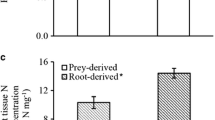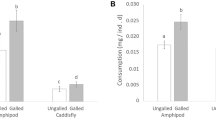Abstract
Uptake of nitrogen from prey and substrate and partitioning of prey-derived nitrogen were studied in the carnivorous plant species Pinguicula alpina, P. villosa, P. vulgaris and Drosera rotundifolia in a subarctic environment. Efficiency in nitrogen uptake from prey was evaluated by tracing 15N from 15N-enriched Drosophila flies fed to the plants. The in situ uptake efficiency differed somewhat between species and ranged from 29 to 41% of prey N. This efficiency was not affected by different feeding levels or plant reproductive status (flowering or non-flowering). A test of the amount of N absorbed from prey caught on flower stalks of Pinguicula villosa and P. vulgaris showed that both species took up little of what was available in prey (2.5% or less). The uptake efficiency found in greenhouse grown plants was higher than in plants in situ (40–50% vs. 30–40% respectively). This could probably best be explained by the absence of rain and a higher temperature in the greenhouse. The prey-derived 15N was traced to reproductive organs and winter buds. Non-flowering individuals allocated 58–97% of the N derived from prey to their winter buds. Flowering individuals allocated 17–43% of the N income from prey to reproduction, while 34–71% were allocated to buds. Root uptake of nitrogen was stimulated by increased prey capture. This increase in uptake of nitrogen from the substrate was larger than the potential direct uptake of nitrogen from captured prey.
Similar content being viewed by others
References
Aldenius J, Carlsson B, Karlsson S (1983) Effects of insect trapping on growth and nutrient content of Pinguicula vulgaris L. in relation to the nutrient content of the substrate. New Phytol 93: 53–59
Chandler GE, Anderson JW (1976) Studies on the nutrition and growth of Drosera species with reference to the carnivorous habit. New Phytol 76: 129–141
Dixon KD, Pate JS, Bailey WJ (1980) Nitrogen nutrition of the tuberous sundew Drosera erythrorhiza Lindl. with special reference to catch of arthropod fauna by its glandular leaves. Aust J Bot 28: 283–297
Friday L, Quarmby C (1994) Uptake and translocation of prey-derived 15N and 32P in Utricularia vulgaris L. New Phytol 126: 273–281
Griffiths H (1991) Applications of stable isotope technology in physiological ecology. Funct Ecol 5: 254–269
Handley LL, Raven JA (1992) The use of natural abundance of nitrogen isotopes in plant physiology and ecology. Plant Cell Environ 15: 965–985
Heslop-Harrison Y, Knox RB (1971) A cytochemical study of the leaf gland enzymes of insectivorous plants of the genus Pinguicula. Planta 96: 183–211
Jaffe K, Michelangeli F, Gonzales JM, Miras B, Ruiz MC (1992) Carnivory in pitcher plants of the genus Heliamphora (Sarraceniaceae). New Phytol 122: 733–744
Karlsson PS (1986) Seasonal pattern of biomass allocation in flowering and nonflowering specimens of three Pinguicula species. Can J Bot 64: 2872–2877
Karlsson PS (1988) Seasonal patterns of nitrogen, phosphorus and potassiumutilization by three Pinguicula species. Funct Ecol 2: 203–209
Karlsson PS, Carlsson B (1984) Why does Pinguicula vulgaris L. trap insects? New Phytol 97: 25–30
Karlsson PS, Pate JS (1992) Contrasting effects of supplementary feeding of insects or mineral nutrients on the growth and nitrogen and phosphorus economy of pygmy species of Drosera. Oecologia 92: 8–13
Karlsson PS, Nordell KO, Eirefeldt S, Svensson A (1987) Trapping efficiency of three carnivorous Pinguicula species. Oecologia 73: 518–521
Karlsson PS, Svensson BM, Carlsson BÅ, Nordell KO (1990) Resource investment in reproduction and its consequences in three Pinguicula species. Oikos 59: 393–398
Karlsson PS, Thorén LM, Hanslin HM (1994) Prey capture by three Pinguicula species in a subarctic environment Oecologia 99: 88–193
Lid J, Lid DT (1994) Norsk flora, 6th edn. Det Norske Samlag, Oslo
Molau U (1993) Reproductive ecology of the three Nordic Pinguicula species (Lentibulariaceae). Nord J Bot 13: 149–157
Schulze E-D, Gebauer G, Schulze W, Pate JS (1991) The utilization of nitrogen from insect capture by different growth forms of Drosera from Southwest Australia Oecologia 87: 240–246
Thum M (1986) Segregation of habitat and prey in two sympatric carnivorous plant species, Drosera rotundifolia and Drosera intermedia Oecologia 70: 601–605
Thum M (1988) The significance of carnivory for the fitness of Drosera in its natural habitat 1. The reactions of Drosera intermedia and Drosera rotundifolia to supplementary feeding. Oecologia 75: 472–480
Thum M (1989) The significance of carnivory for the fitness of Drosera in its natural habitat 2. The amount of captured prey and its effect on Drosera intermedia and Drosera rotundifolia. Oecologia 81: 401–411
Watson AP, Matthiessen JN, Springett BP (1982) Arthropod associates and macronutrient status of the red-ink sundew (Drosera erythrorhiza Lindl.). Aust J Ecol 7: 13–22
Zamora R (1990) The feeding ecology of a carnivorous plant (Pinguicula neyadense): prey analysis and capture constraints. Oecologia 84: 376–379
Zar JH (1984) Biostatistical analysis, 2nd ed. Prentice-Hall, Englewood Cliffs, pp 199–201
Author information
Authors and Affiliations
Rights and permissions
About this article
Cite this article
Hanslin, H.M., Karlsson, P.S. Nitrogen uptake from prey and substrate as affected by prey capture level and plant reproductive status in four carnivorous plant species. Oecologia 106, 370–375 (1996). https://doi.org/10.1007/BF00334564
Received:
Accepted:
Issue Date:
DOI: https://doi.org/10.1007/BF00334564




